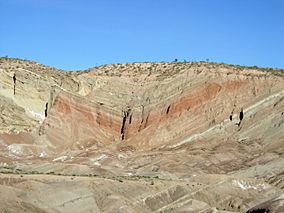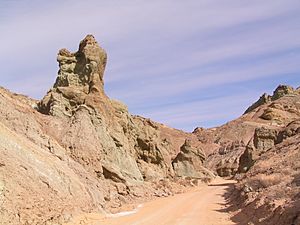Rainbow Basin facts for kids
Quick facts for kids Rainbow Basin Natural Area |
|
|---|---|

The famous Rainbow Basin syncline
|
|
| Location | San Bernardino County, California |
| Nearest city | Barstow |
| Area | 1,961 acres (794 ha) |
| Designated: | 1966 |
Rainbow Basin is an amazing place with colorful rock formations. It's located about 8 miles north of Barstow in the Mojave Desert in San Bernardino County, California.
This special area has been named a National Natural Landmark. It's managed by the Bureau of Land Management as the Rainbow Basin Natural Area. Even though some parts are privately owned, the public can visit. You can get there by taking Irwin Road from Barstow to a dirt loop road that goes through the colorful basin.
Rainbow Basin is famous for a few cool things:
- Its beautiful and unique rock shapes.
- Its fossil beds, which have taught scientists a lot about animals that lived 12 to 16 million years ago.
- The Calico Early Man Site is also nearby to the northeast.
Contents
How Rainbow Basin Formed



Deep under Rainbow Basin, there's a huge mass of rock called a batholith. This batholith is made of a rock called quartz monzonite. It formed a very long time ago, during the Cretaceous or late Jurassic period.
Millions of years ago, this batholith was pushed downwards, creating a bowl-like shape, or a basin. Over time, sedimentary rocks formed in this basin. These are the colorful layers you see today. Later, more forces from the Earth pushed and pulled these rocks, making them fold deeply. The most famous fold is called the Barstow Syncline. These forces also created cracks in the ground called faults.
The thick layers of rock in Rainbow Basin can be split into three main groups:
Jackhammer Formation
This is the lowest and oldest layer. It's made of sandstone, siltstone, limestone, and conglomerate. These rocks probably formed during the early Miocene Epoch.
Pickhandle Formation
Above the Jackhammer Formation is the Pickhandle Formation. Most of the rocks here came from volcanic eruptions. They include tuff, rhyolite, and andesite. This shows that volcanoes were very active in the area during the early Miocene.
Barstow Formation
This is the highest of the three main layers. It's made of conglomerate, limestone, sandstone, and shale. This layer formed during the middle to late Miocene period. It holds one of the biggest collections of Cenozoic fossils in North America! Most of these layers were laid down by ancient streams. There's also a special white layer of rhyolitic tuff near the top, sometimes called marker tuff.
Finally, on top of everything, there's a thinner layer of fanglomerate. These are deposits from alluvial fans that formed during the late Pleistocene Ice Age. The different hardness of these rocks, combined with erosion (wind and water wearing them away), created the amazing and colorful shapes we see in Rainbow Basin today.
Amazing Fossil Beds

Most of the fossils in Rainbow Basin are found in the rocks of the Barstow Formation. These fossils tell us about many animals that used to live here but are not found in California today. Imagine finding fossils of camels, horses, mastodons (like elephants), and even flamingos!
This special collection of animals helps scientists understand a time period called the Barstovian Land Mammal age. In 1941, Rainbow Basin was chosen as the main place to study and define this important time in Earth's history.
Visiting Rainbow Basin
Rainbow Basin is open for everyone to explore! You can drive through it on a one-way dirt road that loops around the basin.
There is no camping allowed inside Rainbow Basin itself. However, the Owl Canyon Campground is very close by if you want to stay overnight.
It's important to remember that you cannot collect fossils or rocks without a special permit. Since Rainbow Basin is a desert area, always be prepared. Bring plenty of water, wear sunscreen, and take other safety steps for visiting a desert.
- Official Rainbow Basin Natural Area website
See also
 In Spanish: Rainbow Basin para niños
In Spanish: Rainbow Basin para niños




